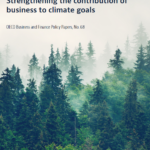At COP16 in Cali, Colombia, the issue of “biodiversity credits” has been central to discussions on biodiversity preservation. Inspired by carbon credits, these financial instruments aim to incentivize beneficial actions for ecosystems by rewarding positive initiatives for nature. However, their relevance is debated: some see them as a necessary solution to biodiversity collapse, while others view them as a false solution, prone to similar abuses observed with carbon credits. An advisory committee, the International Advisory Panel on Biodiversity Credits (IAPB), presented a roadmap to guide their use, yet this approach faces strong opposition from numerous civil society and environmental organizations.
The Objectives and Proposed Framework for Biodiversity Credits
Biodiversity credits are based on the idea of financially rewarding actions with a measurable positive impact on ecosystems, alongside efforts to combat biodiversity decline. Inspired by carbon compensation mechanisms, this approach proposes that funding should support the conservation or restoration of natural environments. At COP16, the IAPB proposed a series of principles to regulate these credits and avoid the pitfalls seen in carbon markets. In particular, the committee recommends a localized approach, where each credit would correspond to specific actions involving local populations and be measured transparently. Additionally, they suggest limiting credit trading to national markets, overseen by governments, to avoid excessive commercialization and the risks posed by a global market that could undermine the credibility of this instrument.
Controversies and Criticisms Surrounding Biodiversity Credits
Biodiversity credits face numerous criticisms, especially from environmental organizations and economists focused on environmental policy. Critics argue that compensating for environmental degradation with biodiversity credits could encourage a “destroy-and-repair” logic rather than protecting natural spaces proactively. According to some opponents, this system could lead to greenwashing, allowing companies to offset biodiversity impacts without addressing their root causes. Furthermore, the complexity of measuring biodiversity benefits raises concerns about the true effectiveness of these credits. Environmental advocates also warn that this approach risks diluting conservation efforts, noting that redirecting subsidies currently allocated to polluting industries toward nature protection initiatives would be a more effective strategy.
Perspectives and Limitations of Biodiversity Credits
Despite the debates, biodiversity credits present a significant funding potential for ecosystems, particularly in developing countries where resources for conservation are limited. According to the World Economic Forum’s projections, these markets could generate tens of billions of euros by 2050. However, the IAPB report emphasizes that biodiversity credits cannot replace coherent, ambitious public policies. While they could encourage companies to reduce their environmental impact by improving their value chains, strict safeguards are essential to prevent misuse. Ultimately, biodiversity credits could play a complementary role in nature protection, provided they are well-regulated and limited to projects with a strong, measurable, and verifiable positive environmental impact.
Conclusion
Similar to carbon credits, the issue of fund traceability linked to a verifiable impact measure is essential. If fund mobilization effectively protects high-value environmental areas, this instrument will be relevant. However, if this financial instrument dilutes “assets” into complex and untraceable funds, it risks becoming a tool for speculation and compensation linked to further environmental degradation — thus validating the risk of greenwashing.
Author of several books and resources on business, sustainability and responsibility. Working with top decision makers pursuing transformational changes for their organizations, leaders and industries. Working with executives improving resilience and competitiveness of their company and products given their climate and human right business agendas. Connect with Farid Baddache on Twitter at @Fbaddache.






